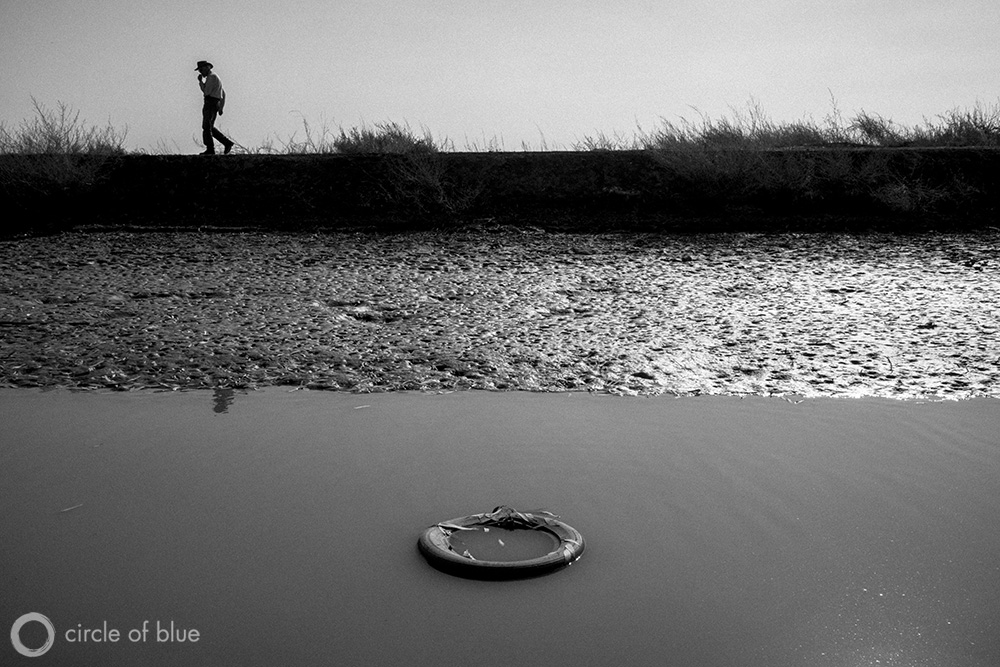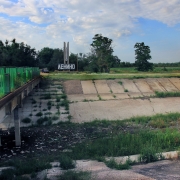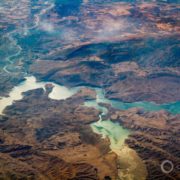2015 Water Preview, Part II: National – States React to New Era of Water Scarcity
Water is priority in state legislatures and governors’ offices.

By Brett Walton
Circle of Blue
Water roared to life in state politics in 2014. California, its hand forced by a nasty drought, brought its groundwater laws out of the Gold Rush era and into line with nearly every other state in the union. Meanwhile, New York Governor Andrew Cuomo (D) banned fracking for natural gas, in large part because of concerns about water pollution.
Kansas debated how to cope with a shrinking Ogallala Aquifer, the state’s main source of irrigation water. Voters in California, Florida, and Maine endorsed new state spending on water conservation, water-treatment plants, pollution clean-up, and river restoration. And more than one dozen states, spooked by drought and needing guidance, discussed or submitted new water plans.
Taken together, these actions represent an awakening in the United States that water supplies are not as abundant as once thought. A series of severe droughts in recent years — from Texas in 2011 to the Midwest in 2012 to California today — is the frontline reality of a hotter, drier era that is forcing state leaders to take stock of their water assets and reevaluate laws, regulations, and investment strategies.
More is coming in 2015.
Infrastructure Spending
In states that voted for water spending, leaders this year will open the public purse. The Texas Water Development Board, a loan-making agency, will distribute funds from a $US 2 billion pot of money that voters approved in 2013. Applications for the first round of loans are due in February, and the loans will close by December. Though much of the money will be spent on new pipes, wells, reservoirs, and treatment plants, state law requires at least 20 percent go toward water conservation and recycling.
The Florida Legislature also will spend a pile of cash, in its case from a fund that is seeded by real estate taxes and is designated for land and water conservation. Approved at the ballot box in November 2014, the fund could generate between $US 10 billion and $US 18 billion over 20 years for land purchases, as well as infrastructure investments that are tied to improvements in water quality.
Montana lawmakers will consider a $US 336 million infrastructure package that was proposed by Governor Steve Bullock (D). Thanks to an oil boom in neighboring North Dakota, border counties in the eastern third of the state are outgrowing their water and sewer grids. Roughly one-sixth of the package is dedicated to water, sewer, and irrigation projects.
In California, the nine-member California Water Commission is laying the groundwork for expending some of the $US 7.5 billion in bond money that voters approved in November 2014. The commission, whose members are appointed by the governor, must write the rules for deciding priorities.
Groundwater on the Agenda
Debates about groundwater, as in 2014, will continue to echo in statehouses. Wisconsin, for one, will be a battleground for groundwater regulation. Lawmakers rejected a bill last session that would have forced regulators to approve new wells without considering cumulative effects of groundwater pumping on rivers and lakes. The Wisconsin League of Conservation Voters hopes to keep attention on the state’s aquifers, and the organization is making groundwater legislation one of its top priorities in 2015. Their concern is well placed — an explosion of high-volume irrigation wells in central Wisconsin is causing streams to dry up.
The loudest chatter, however, may come from Texas, a state in which groundwater is essential to urban growth and agriculture. The regulatory landscape, though, has been muddled recently by court cases that suggest landowners should be compensated if their ability to pump groundwater is restricted. Texas faces shrinking water tables and high demand for groundwater, a combination of factors that is driving keen interest in the subterranean resource.
Texas lawmakers will consider two important issues, according to Mary Kelly, head of Parula, an Austin-based consultancy. First, they will look at the length of water-use permits that are handed out by groundwater management districts. Private developers that want to sell or lease groundwater to cities desire longer permits to secure financing.
Lawmakers will also debate whether brackish groundwater — the slightly salty supplies that Texas has in abundance — should be regulated in the same way as fresh groundwater. Brackish groundwater was one of the issues that legislators in both chambers studied in depth during recess.
But changes in the state’s leadership add uncertainty to the legislative process this year, Kelly said.
“We have a lot of new faces in the Senate and the House, new committee chairs, as well as a new governor and lieutenant governor,” Kelly told Circle of Blue. “That makes it uncertain how much will move on water.”
State Plans and Interstate Disputes
In addition to new laws, several states — Arkansas, Colorado, Kansas, and Montana among them — will be finalizing water plans that were introduced in 2014. Both Arkansas and Colorado are proposing multibillion-dollar infrastructure projects. In the case of Arkansas, new canals will wean farmers from unsustainable groundwater use. In Colorado, the growing cities of the Front Range are looking to move more water across the continental divide from the Colorado River Basin.
Other states, meanwhile, will hope that long-running legal disputes will be resolved this year in the U.S. Supreme Court. Texas has sued New Mexico over declining flows in the Rio Grande, while Florida successfully petitioned the justices to consider Georgia’s use of water from shared rivers.
Even if lawmakers avoid big actions, the water plan discussions and lawsuits ensure that water will be a top-of-the policy-heap concern in 2015.
Brett writes about agriculture, energy, infrastructure, and the politics and economics of water in the United States. He also writes the Federal Water Tap, Circle of Blue’s weekly digest of U.S. government water news. He is the winner of two Society of Environmental Journalists reporting awards, one of the top honors in American environmental journalism: first place for explanatory reporting for a series on septic system pollution in the United States(2016) and third place for beat reporting in a small market (2014). He received the Sierra Club’s Distinguished Service Award in 2018. Brett lives in Seattle, where he hikes the mountains and bakes pies. Contact Brett Walton











I wrote a bit on US water scarcity and what should be considered to adapt. See “Regional Scarcity” here: http://digital.distributedenergy.com/publication/?i=33308
Nevada is able to reuse 40% of its water resources:
https://ndep.nv.gov/forum/recycled_water_policy09.pdf
(slide 4) and somehow extend its 300KAF allotment of the Colorado River, into 500KAF by returning water to the river for credit. Granted, Nevada is not an agricultural powerhouse, but we certainly would not use water credits to flood fields, or grow rice, alfalfa, or almonds either.
http://www.arb.ca.gov/fuels/lcfs/workgroups/lcfssustain/hanson.pdf
(slide 13)
BTW, the Brock Reservoir saved almost 150KAF this year, after saving over 120KAF the past few years. It was projected to save up to 70KAF/year when it was conceived. That’s over half of the consumption of the State of Nevada, and yet no one writes about this success story. Who financed the majority of this project? SNWA
http://www.usbr.gov/lc/yuma/facilities/Brock/yao_brock.html
They have always understood that they live in the desert. CA has yet to come to grips with this fact.